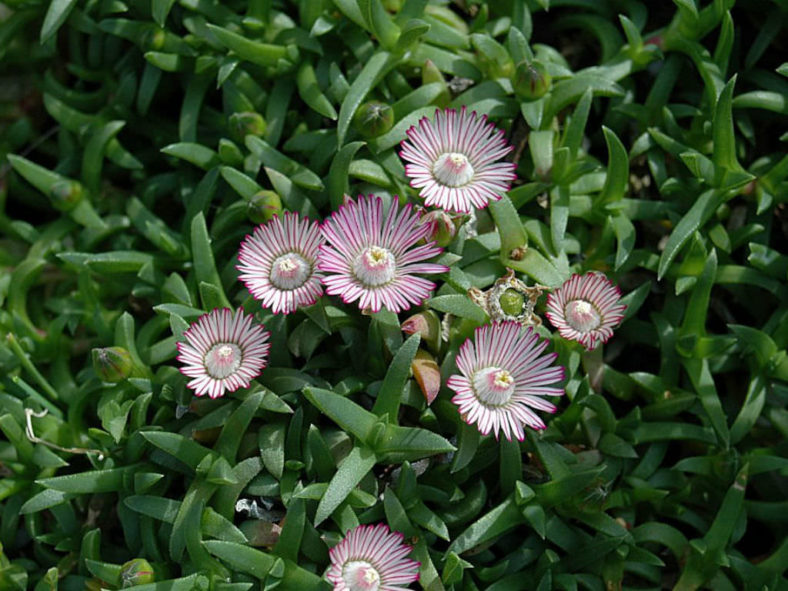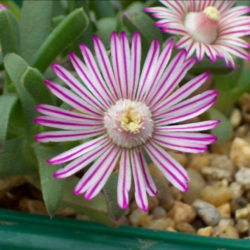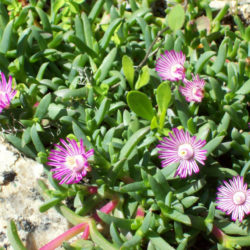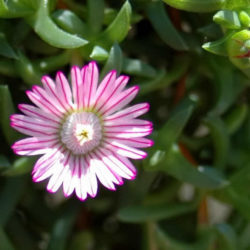Scientific Name
Ruschia lineolata Schwantes
Common Name(s)
Carpet of Stars
Synonym(s)
Mesembryanthemum lineolatum
Scientific Classification
Family: Aizoaceae
Subfamily: Ruschioideae
Tribe: Ruschieae
Genus: Ruschia
Description
Ruschia lineolata is a mat-forming succulent shrublet with reddish, much-branched stems that bear bluish-green, narrow, pointed leaves. It can grow up to 6 inches (15 cm) tall. The smooth, fleshy leaves are held in opposite pairs, at a right angle to the one above and below it, with the new leaves emerging like small, pursed lips. They are triangular in cross-section and can reach 0.6 inches (1.5 cm) in length and 0.2 inches (0.5 cm) in width.
From late winter to early spring, the plant produces flowers with numerous narrow, white petals with a distinct magenta-pink midstripe and a cone-shaped cluster of stamens and staminodes in the center. There can also be a second lighter flowering in fall. The flowers are up to 0.8 inches (2 cm) in diameter. The fruits are capsules with five locules.
Origin
Ruschia lineolata is native to South Africa. It grows on shale ridges of dry streambeds and sandy or loamy soils in scrub south of the Langeberg Mountains from Caledon to Humansdorp.
Etymology
The specific epithet "lineolata (lin-ee-oh-LAY-ta)" means "marked (longitudinally) with fine lines; lineolate" and refers to the lines that occur along the center of each petal.

Hardiness
USDA hardiness zone 9a to 11b: from 20 °F (−6.7 °C) to 50 °F (+10 °C).
How to Grow and Care
Ruschias are popular for use in the garden. Their drought tolerance makes them ideal water-wise plants in the arid and semi-arid parts of the world. Brilliant seasonal color displays can be achieved by mass planting in large areas and using many different growth forms.
There are tufted, round-shaped plants well suited for containers and flower boxes. The low-growing and spreading species cover well, will do wonders to terraces and embankments, and will easily stabilize loose sand. Then there are the bigger, more robust types best used among larger plants or combined with other succulents in rock gardens and mixed beds.
Remember that Ruschias are short-lived, and it is essential to continue replanting every three years. As mentioned before, all species attract a host of insects and are thus ideal subjects to attract wildlife to the garden throughout the year.
Once rooted or germinated, cuttings and seedlings can be feed with organic fertilizers to enhance vigor and health. There are not many serious pests that attack Ruschia. It is probably better to first use biological control when pests are detected.
See more at How to Grow and Care for Ruschia.
Links
- Back to genus Ruschia
- Succupedia: Browse succulents by Scientific Name, Common Name, Genus, Family, USDA Hardiness Zone, Origin, or cacti by Genus
Photo Gallery
Click on a photo to see a larger version.


